A Layer-Adapted Numerical Method for Singularly Perturbed Partial Functional-Differential Equations
Abstract
1. Introduction
2. The Continuous Problem
2.1. A Priori Estimates for the Negative Shifts
2.2. Solution Bounds
3. The Discrete Problem
3.1. Time Semi-Discrete Problem
3.2. Shishkin-Type Solution Decomposition
3.3. Fully Discrete Problem
4. Convergence Analysis
5. Numerical Computations and Discussion
6. Conclusions
Author Contributions
Funding
Data Availability Statement
Acknowledgments
Conflicts of Interest
References
- Tzou, D.Y. Macro-to Microscale Heat Transfer; CRC Press: Boca Raton, FL, USA, 1997. [Google Scholar]
- Joseph, D.D.; Preziosi, L. Heat waves. Rev. Mod. Phys. 1989, 61, 41, Erratum in Rev. Mod. Phys. 1990, 62, 375–391. [Google Scholar] [CrossRef]
- Derstine, M.W.; Gibbs, H.M.; Hopf, F.A.; Kaplan, D.L. Bifurcation gap in a hybrid optically bistable system. Phys. Rev. A 1982, 26, 3720. [Google Scholar] [CrossRef]
- Liu, Q.; Wang, X.; De Kee, D. Mass transport through swelling membranes. Int. J. Eng. Sci. 2005, 43, 1464–1470. [Google Scholar] [CrossRef]
- Liao, X. Hopf and resonant codimension two bifurcation in van der Pol equation with two time delays. Chaos Solitons Fractals. 2005, 23, 857–871. [Google Scholar] [CrossRef]
- Mackey, M.C.; Glass, L. Oscillation and chaos in physiological control systems. Science 1977, 197, 287–289. [Google Scholar] [CrossRef] [PubMed]
- Lasota, A.; Wazewska, M. Mathematical models of the red blood cell system. Mat. Stos. 1976, 6, 25–40. [Google Scholar]
- Ramesh, V.; Kadalbajoo, M.K. Upwind and midpoint upwind difference methods for time-dependent differential difference equations with layer behavior. Appl. Math. Comput. 2008, 202, 453–471. [Google Scholar] [CrossRef]
- Kumar, D.; Kadalbajoo, M.K. A parameter-uniform numerical method for time-dependent singularly perturbed differential-difference equations. Appl. Math. Model. 2011, 35, 2805–2819. [Google Scholar] [CrossRef]
- Bansal, K.; Sharma, K.K. Parameter uniform numerical scheme for time dependent singularly perturbed convection-diffusion-reaction problems with general shift arguments. Numer. Algorithms. 2017, 75, 113–145. [Google Scholar] [CrossRef]
- Kumar, D. An implicit scheme for singularly perturbed parabolic problem with retarded terms arising in computational neuroscience. Numer. Methods Partial. Differ. Equ. 2018, 34, 1933–1952. [Google Scholar] [CrossRef]
- Nageshwar Rao, R.; Podila, P.C. Fitted numerical methods for singularly perturbed one-dimensional parabolic partial differential equations with small shifts arising in the modelling of neuronal variability. Differ. Equ. Dyn. Syst. 2019, 27, 1–18. [Google Scholar] [CrossRef]
- Gupta, V.; Kumar, M.; Kumar, S. Higher order numerical approximation for time dependent singularly perturbed differential-difference convection-diffusion equations. Numer. Methods Partial. Differ. Equ. 2018, 34, 357–380. [Google Scholar] [CrossRef]
- Podila, P.C.; Kumar, K. An adaptive mesh method for time dependent singularly perturbed differential-difference equations. Nonlinear Eng. 2019, 8, 328–339. [Google Scholar]
- Ramesh, V.; Priyanga, B. Higher order uniformly convergent numerical algorithm for time-dependent singularly perturbed differentialdifference equations. Differ. Equ. Dyn. Syst. 2021, 29, 239–263. [Google Scholar] [CrossRef]
- Shivhare, M.; Podila, P.C.; Ramos, H.; Vigo-Aguiar, J. Quadratic B-spline collocation method for time dependent singularly perturbed differential-difference equation arising in the modeling of neuronal activity. Numer. Methods Partial. Differ. Equ. 2023, 39, 1805–1826. [Google Scholar] [CrossRef]
- Daba, I.T.; Duressa, G.F. Extended cubic B-spline collocation method for singularly perturbed parabolic differential-difference equation arising in computational neuroscience. Int. J. Numer. Method Biomed. Eng. 2021, 37, e3418. [Google Scholar] [CrossRef] [PubMed]
- Takele Daba, I.; File Duressa, G. A hybrid numerical scheme for singularly perturbed parabolic differential-difference equations arising in the modeling of neuronal variability. Comput. Math. Methods 2021, 3, e1178. [Google Scholar] [CrossRef]
- Daba, I.T.; Duressa, G.F. Uniformly convergent numerical scheme for a singularly perturbed differential-difference equations arising in computational neuroscience. J. Appl. Math. Inform. 2021, 39, 655–676. [Google Scholar]
- Woldaregay, M.M.; Duressa, G.F. Uniformly convergent hybrid numerical method for singularly perturbed delay convection-diffusion problems. Int. J. Differ. Equ. 2021, 2021, 6654495. [Google Scholar] [CrossRef]
- Daba, I.T.; Duressa, G.F. Collocation method using artificial viscosity for time dependent singularly perturbed differential–difference equations. Math. Comput. Simul. 2022, 192, 201–220. [Google Scholar] [CrossRef]
- Bansal, K.; Sharma, K.K. ε-uniform numerical technique for the class of time dependent singularly perturbed parabolic problems with state dependent retarded argument arising from generalised steins model of neuronal variability. Differ. Equ. Dyn. Syst. 2019, 27, 113–140. [Google Scholar] [CrossRef]
- Daba, I.T.; Duressa, G.F. Hybrid algorithm for singularly perturbed delay parabolic partial differential equations. Int. J. (AAM) 2021, 16, 21. [Google Scholar]
- Daba, I.T.; Duressa, G.F. A robust computational method for singularly perturbed delay parabolic convection-diffusion equations arising in the modeling of neuronal variability. Comput. Methods Differ. Equ. 2022, 10, 475–488. [Google Scholar]
- Vrabel, R. Lower and upper solution method for semilinear, quasi-linear and quadratic singularly perturbed Neumann boundary value problems. Axioms 2023, 12, 154. [Google Scholar] [CrossRef]
- Kalimbetov, B.; Safonov, V.; Zhaidakbayeva, D. Asymptotic solution of a singularly perturbed integro-differential equation with exponential inhomogeneity. Axioms 2023, 12, 241. [Google Scholar] [CrossRef]
- Arumugam, P.; Thynesh, V.; Muthusamy, C.; Ramos, H. A quintic spline-based computational method for solving singularly perturbed periodic boundary value problems. Axioms 2025, 14, 73. [Google Scholar] [CrossRef]
- Kumar, B.R.; Kumar, S. Convergence of three-step Taylor Galerkin finite element scheme based monotone Schwarz iterative method for singularly perturbed differential-difference equation. Numer. Funct. Anal. Optim. 2015, 36, 1029–1045. [Google Scholar] [CrossRef]
- Kumar, S.; Rathish Kumar, B.V.; Ten Thije Boonkkamp, J.H.M. Complete flux scheme for parabolic singularly perturbed differential-difference equations. Numer. Methods Partial. Differ. Equ. 2019, 35, 790–804. [Google Scholar] [CrossRef]
- Kumar, S.; Kumar, B.R. A domain decomposition Taylor Galerkin finite element approximation of a parabolic singularly perturbed differential equation. Appl. Math. Comput. 2017, 293, 508–522. [Google Scholar] [CrossRef]
- Kumar, S.; Kumar, B.R. A finite element domain decomposition approximation for a semilinear parabolic singularly perturbed differential equation. Int. J. Nonlinear Sci. Numer. Simul. 2017, 18, 41–55. [Google Scholar] [CrossRef]
- Kabeto, M.J.; Duressa, G.F. Robust numerical method for singularly perturbed semilinear parabolic differential difference equations. Math. Comput. Simul. 2021, 188, 537–547. [Google Scholar] [CrossRef]
- Woldaregay, M.M.; Duressa, G.F. Accurate numerical scheme for singularly perturbed parabolic delay differential equation. BMC Res. Notes. 2021, 14, 358. [Google Scholar] [CrossRef] [PubMed]
- Woldaregay, M.M.; Duressa, G.F. Robust numerical method for singularly perturbed parabolic differential equations with negative shifts. Filomat 2021, 35, 2383–2401. [Google Scholar] [CrossRef]
- Woldaregay, M.M.; Duressa, G.F. Almost second-order uniformly convergent numerical method for singularly perturbed convection- diffusion–reaction equations with delay. Filomat 2023, 102, 651–671. [Google Scholar] [CrossRef]
- Lange, C.G.; Miura, R.M. Singular perturbation analysis of boundary value problems for differential-difference equations. V. Small shifts with layer behavior. SIAM J. Appl. Math. 1994, 54, 249–272. [Google Scholar] [CrossRef]
- Kellogg, R.B.; Tsan, A. Analysis of some difference approximations for a singular perturbation problem without turning points. Math. Comput. 1978, 32, 1025–1039. [Google Scholar] [CrossRef]
- Clavero, C.; Gracia, J.L.; Jorge, J. High-order numerical methods for one-dimensional parabolic singularly perturbed problems with regular layers. Numer. Methods Partial. Differ. Equ. 2005, 21, 149–169. [Google Scholar] [CrossRef]
- Clavero, C.; Gracia, J.L.; Stynes, M. A simpler analysis of a hybrid numerical method for time-dependent convection–diffusion problems. J. Comput. Appl. Math. 2011, 235, 5240–5248. [Google Scholar] [CrossRef][Green Version]
- Stynes, M.; Roos, H.-G. The midpoint upwind scheme. Appl. Numer. Math. 1997, 23, 361–374. [Google Scholar] [CrossRef]
- Clavero, C.; Jorge, J.; Lisbona, F. A uniformly convergent scheme on a nonuniform mesh for convection-diffusion parabolic problems. J. Comput. Appl. Math. 2003, 154, 415–429. [Google Scholar] [CrossRef]
- Zahra, W.; El-Azab, M.; Mhlawy, A.M.E. Spline difference scheme for two-parameter singularly perturbed partial differential equations. J. Appl. Math. Inform. 2014, 32, 185–201. [Google Scholar] [CrossRef]
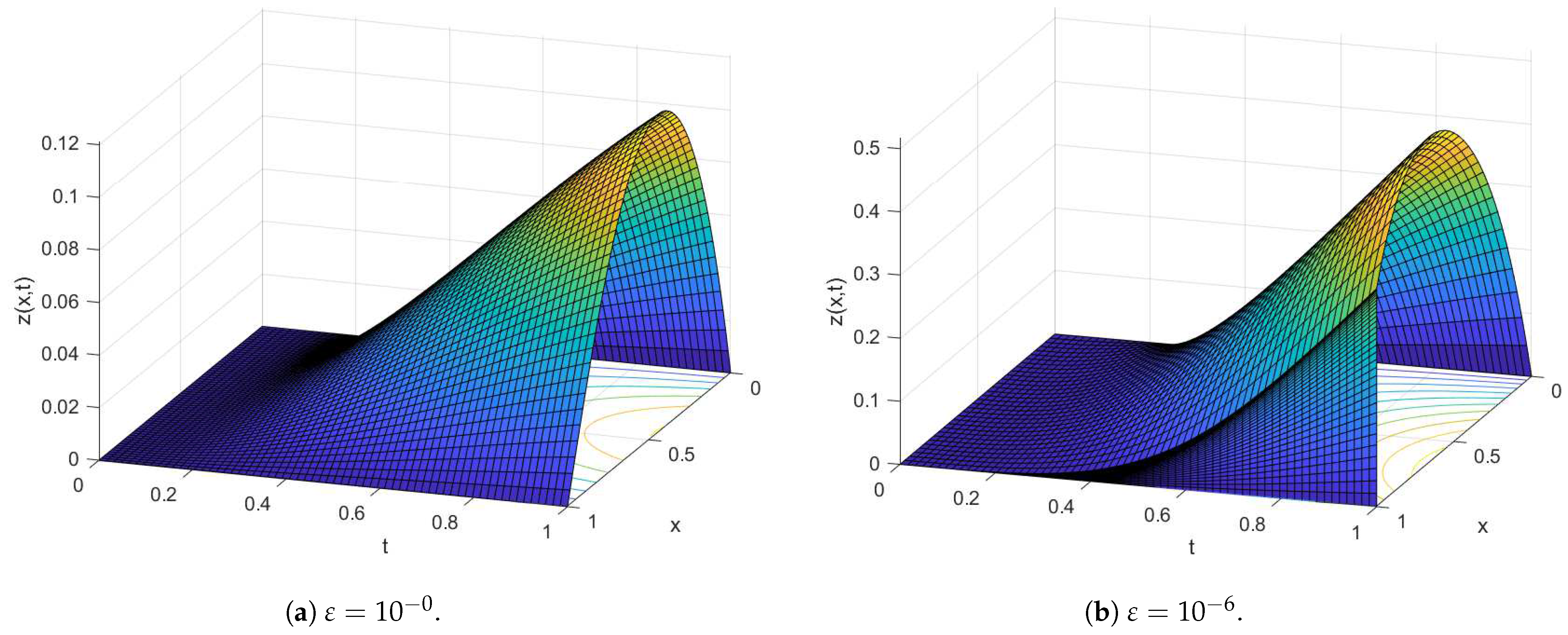

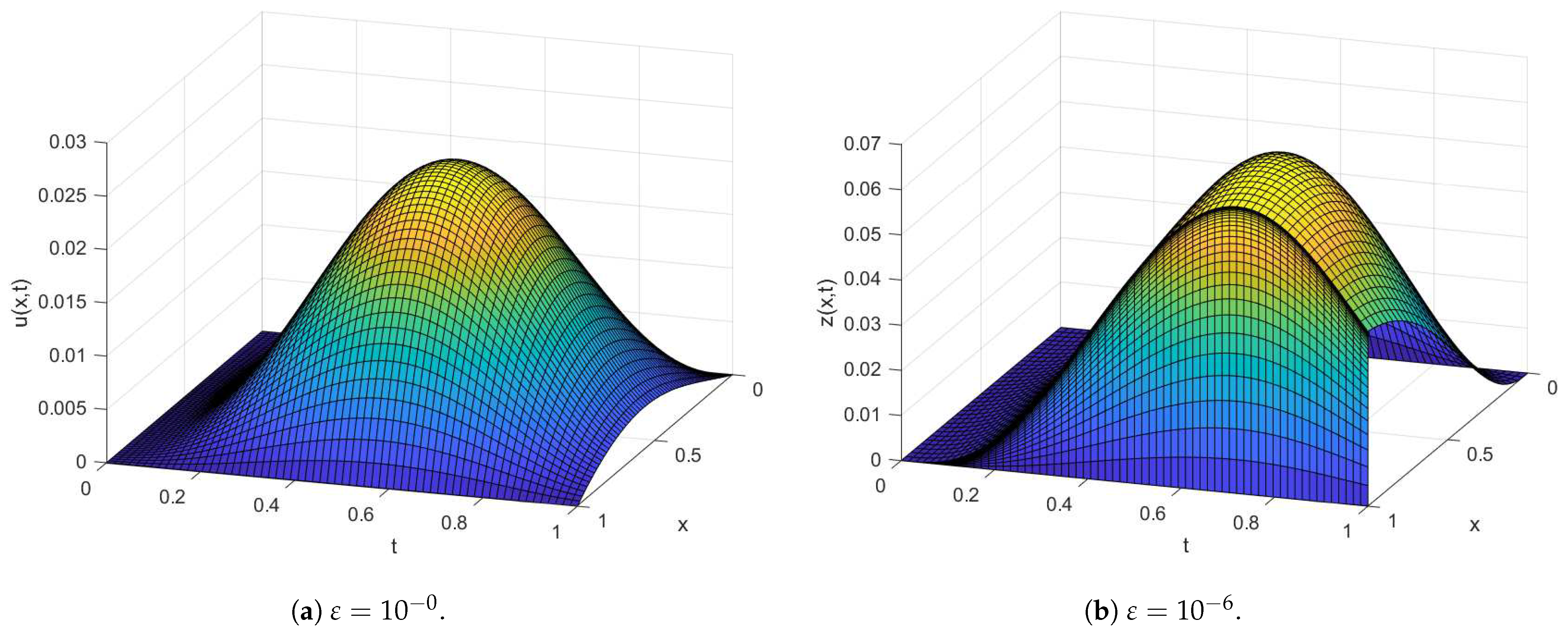

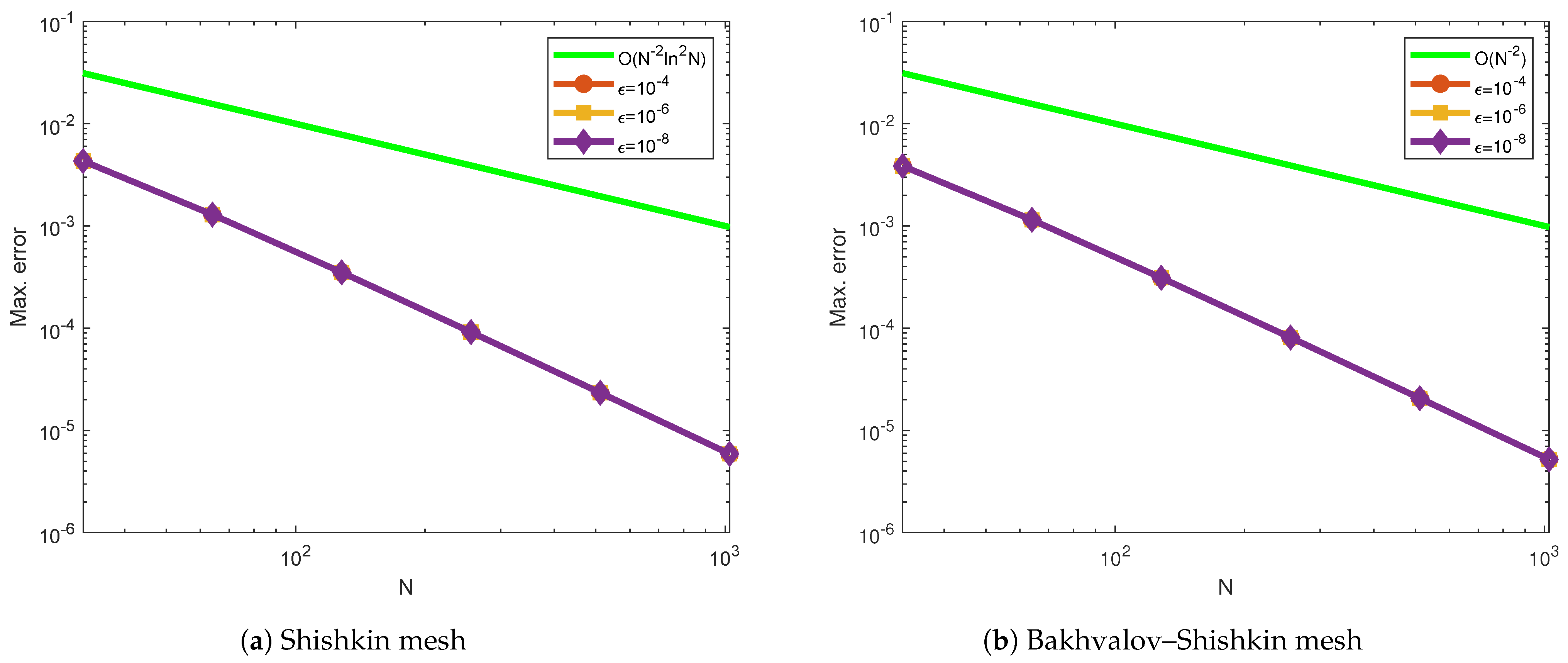
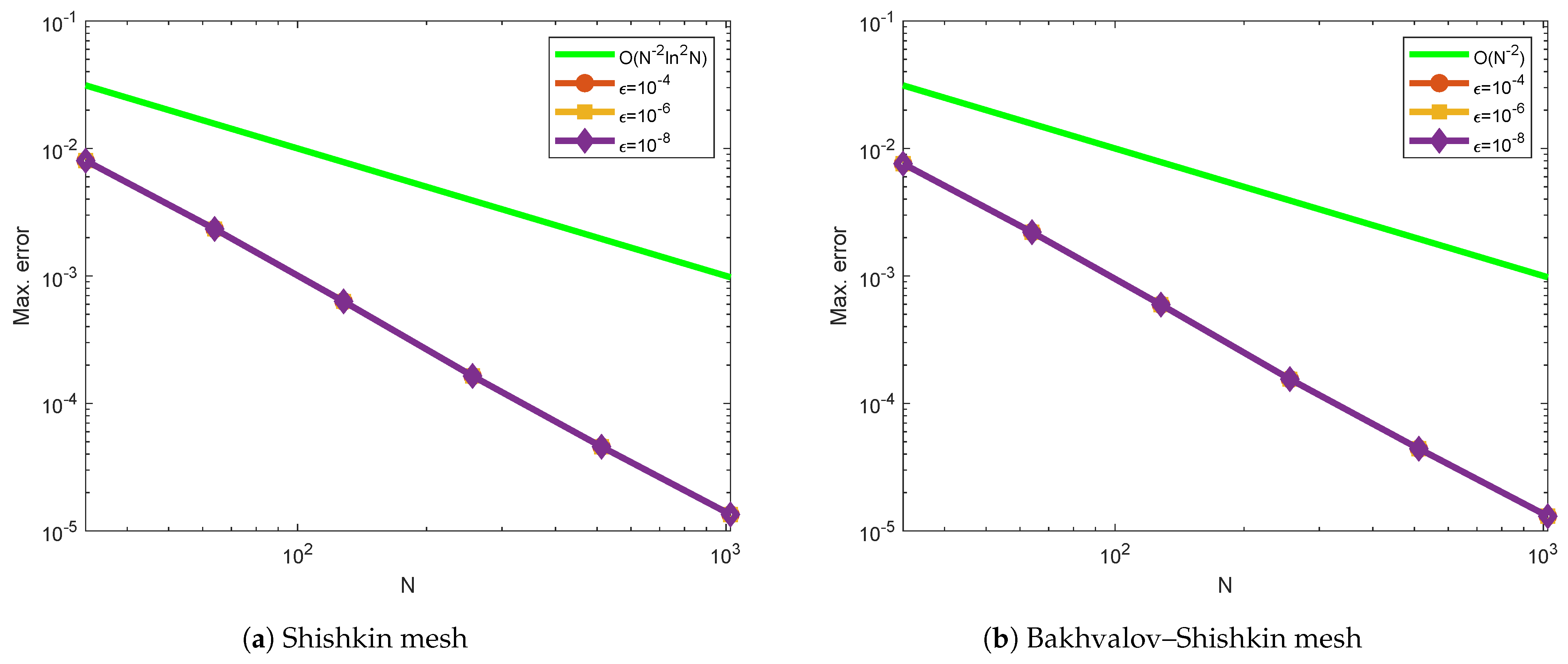

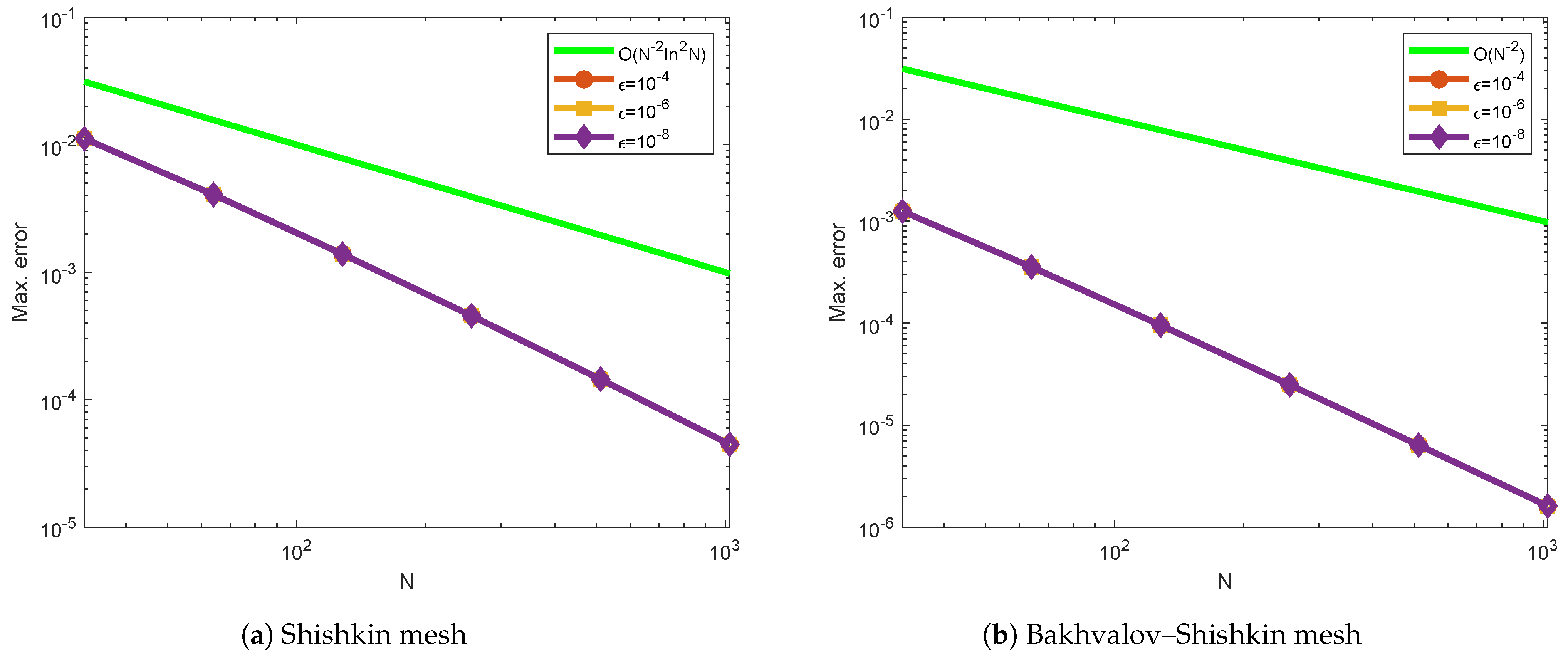

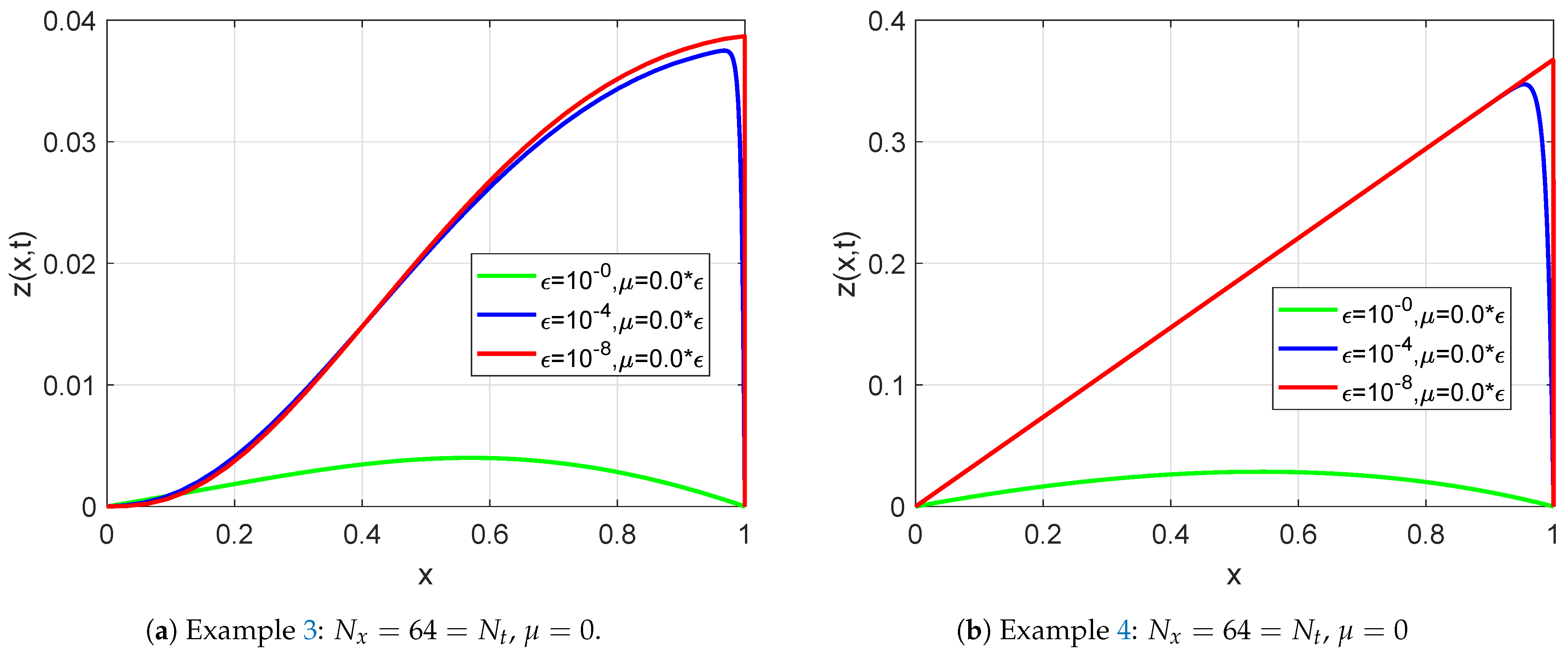
| 64 | 128 | 256 | 512 | 1024 | ||
|---|---|---|---|---|---|---|
| Shishkin mesh | ||||||
| 4.1184 | 1.1994 | 3.1433 | 7.7236 | 1.8156 | 4.2266 | |
| 4.2975 | 1.2828 | 3.4791 | 9.0082 | 2.2718 | 5.6105 | |
| 4.3151 | 1.2911 | 3.5133 | 9.1473 | 2.3310 | 5.8734 | |
| 4.3169 | 1.2919 | 3.5167 | 9.1611 | 2.3368 | 5.8994 | |
| 4.3171 | 1.2920 | 3.5170 | 9.1625 | 2.3374 | 5.9020 | |
| 4.3171 | 1.2920 | 3.5171 | 9.1626 | 2.3374 | 5.9023 | |
| 4.3171 | 1.2920 | 3.5171 | 9.1627 | 2.3375 | 5.9023 | |
| 1.7405 | 1.8771 | 1.9405 | 1.9708 | 1.9856 | ||
| Bakhvalov–Shishkin mesh | ||||||
| 3.6722 | 1.0496 | 2.6770 | 6.0196 | 1.0005 | 1.0352 | |
| 3.8406 | 1.1385 | 3.0783 | 7.9533 | 1.9985 | 4.8703 | |
| 3.8559 | 1.1469 | 3.1110 | 8.0895 | 2.0604 | 5.1904 | |
| 3.8575 | 1.1477 | 3.1142 | 8.1021 | 2.0656 | 5.2138 | |
| 3.8576 | 1.1478 | 3.1145 | 8.1034 | 2.0661 | 5.2160 | |
| 3.8576 | 1.1478 | 3.1145 | 8.1035 | 2.0662 | 5.2162 | |
| 3.8576 | 1.1478 | 3.1145 | 8.1035 | 2.0662 | 5.2163 | |
| 1.7488 | 1.8818 | 1.9424 | 1.9716 | 1.9859 | ||
| 64 | 128 | 256 | 512 | 1024 | ||
|---|---|---|---|---|---|---|
| Shishkin mesh | ||||||
| 7.5337 | 2.1534 | 5.6966 | 1.4486 | 3.6710 | 9.8759 | |
| 7.9721 | 2.3169 | 6.2460 | 1.6187 | 4.1060 | 1.0279 | |
| 8.0169 | 2.3337 | 6.3042 | 1.6384 | 4.4378 | 1.2296 | |
| 8.0214 | 2.3354 | 6.3100 | 1.6404 | 4.5584 | 1.3293 | |
| 8.0219 | 2.3356 | 6.3106 | 1.6406 | 4.5721 | 1.3430 | |
| 8.0219 | 2.3356 | 6.3107 | 1.6406 | 4.5735 | 1.3444 | |
| 8.0219 | 2.3356 | 6.3107 | 1.6406 | 4.5736 | 1.3446 | |
| 1.7802 | 1.8879 | 1.9436 | 1.8428 | 1.7662 | ||
| Bakhvalov–Shishkin mesh | ||||||
| 7.1064 | 2.0070 | 5.1962 | 1.2398 | 2.5523 | 1.1837 | |
| 7.5472 | 2.1847 | 5.8855 | 1.5242 | 3.8564 | 9.7055 | |
| 7.5903 | 2.2015 | 5.9459 | 1.5450 | 4.2760 | 1.1882 | |
| 7.5945 | 2.2033 | 5.9518 | 1.5478 | 4.3958 | 1.2883 | |
| 7.5950 | 2.2035 | 5.9524 | 1.5494 | 4.4094 | 1.3019 | |
| 7.5950 | 2.2035 | 5.9524 | 1.5495 | 4.4107 | 1.3033 | |
| 7.5950 | 2.2035 | 5.9524 | 1.5495 | 4.4109 | 1.3035 | |
| 1.7853 | 1.8883 | 1.9417 | 1.8127 | 1.7587 | ||
| 32 | 64 | 128 | 256 | ||
|---|---|---|---|---|---|
| Present result using Shishkin mesh | |||||
| 1.1780 | 4.3171 | 1.2920 | 3.5171 | 9.1626 | |
| 1.4482 | 1.7405 | 1.8771 | 1.9406 | ||
| Present result using Bakhvalov–Shishkin mesh | |||||
| 1.0698 | 3.8576 | 1.1478 | 3.1145 | 8.1035 | |
| 1.4716 | 1.7488 | 1.8818 | 1.9424 | ||
| Result in [35] Before Extrapolation | |||||
| 1.3567 | 7.7535 | 4.1434 | 2.5115 | - | |
| 0.8072 | 0.9040 | 0.7223 | |||
| Result in [35] After Extrapolation | |||||
| 7.5907 | 2.3678 | 8.2018 | 2.5398 | - | |
| 1.6807 | 1.5295 | 1.6912 | |||
| 32 | 64 | 128 | 256 | ||
|---|---|---|---|---|---|
| Present method using Shishkin mesh | |||||
| 2.4022 | 8.0219 | 2.3356 | 6.3107 | 1.6406 | |
| 1.5823 | 1.7802 | 1.8879 | 1.9436 | ||
| Present method using Bakhvalov–Shishkin mesh | |||||
| 2.2966 | 7.5950 | 2.2035 | 5.9524 | 1.5495 | |
| 1.5964 | 1.7853 | 1.8883 | 1.9417 | ||
| Result in [35] Before Extrapolation | |||||
| 1.2759 | 6.2559 | 3.5761 | 2.1620 | - | |
| 1.0282 | 0.8068 | 0.7260 | |||
| Result in [35] After Extrapolation | |||||
| 6.0561 | 1.5012 | 4.6110 | 1.4750 | - | |
| 2.0123 | 1.7030 | 1.6444 | |||
| 64 | 128 | 256 | 512 | 1024 | ||
|---|---|---|---|---|---|---|
| Shishkin mesh | ||||||
| 1.2027 | 4.0510 | 1.3450 | 4.3745 | 1.3839 | 4.2766 | |
| 1.2028 | 4.0503 | 1.3444 | 4.3705 | 1.3817 | 4.2652 | |
| 1.2028 | 4.0503 | 1.3444 | 4.3701 | 1.3815 | 4.2640 | |
| 1.2028 | 4.0503 | 1.3444 | 4.3701 | 1.3815 | 4.2639 | |
| 1.2028 | 4.0503 | 1.3444 | 4.3701 | 1.3815 | 4.2639 | |
| 1.2028 | 4.0510 | 1.3450 | 4.3745 | 1.3839 | 4.2766 | |
| 1.5700 | 1.5907 | 1.6204 | 1.6604 | 1.6942 | ||
| Bakhvalov–Shishkin mesh | ||||||
| 1.2637 | 3.3122 | 8.5789 | 2.2252 | 5.8937 | 1.6389 | |
| 1.2610 | 3.2858 | 8.4058 | 2.1261 | 5.3620 | 1.3564 | |
| 1.2607 | 3.2831 | 8.3883 | 2.1164 | 5.3105 | 1.3300 | |
| 1.2607 | 3.2829 | 8.3865 | 2.1154 | 5.3054 | 1.3273 | |
| 1.2607 | 3.2828 | 8.3864 | 2.1153 | 5.3049 | 1.3271 | |
| 1.2637 | 3.3122 | 8.5789 | 2.2252 | 5.8937 | 1.6389 | |
| 1.9318 | 1.9489 | 1.9469 | 2.0685 | 1.8464 | ||
| 64 | 128 | 256 | 512 | 1024 | ||
|---|---|---|---|---|---|---|
| Shishkin mesh | ||||||
| 6.5303 | 1.9044 | 6.4562 | 2.1118 | 6.6890 | 2.0650 | |
| 1.0327 | 3.4661 | 1.0499 | 2.8323 | 7.1519 | 2.2079 | |
| 1.1076 | 3.9934 | 1.3397 | 4.2548 | 1.2681 | 3.5204 | |
| 1.1159 | 4.0580 | 1.3831 | 4.5217 | 1.4246 | 4.3420 | |
| 1.1167 | 4.0647 | 1.3877 | 4.5509 | 1.4432 | 4.4558 | |
| 1.1168 | 4.0653 | 1.3881 | 4.5539 | 1.4451 | 4.4676 | |
| 1.1168 | 4.0654 | 1.3882 | 4.5542 | 1.4453 | 4.4688 | |
| 1.1168 | 4.0654 | 1.3882 | 4.5542 | 1.4453 | 4.4689 | |
| 1.4579 | 1.5502 | 1.6079 | 1.6558 | 1.6934 | ||
| Bakhvalov–Shishkin mesh | ||||||
| 1.1649 | 3.1490 | 7.9954 | 1.9744 | 4.8508 | 1.1969 | |
| 1.2416 | 3.5010 | 9.2907 | 2.3694 | 5.8718 | 1.4282 | |
| 1.2506 | 3.5520 | 9.5345 | 2.4773 | 6.3063 | 1.5819 | |
| 1.2515 | 3.5574 | 9.5665 | 2.4902 | 6.3693 | 1.6113 | |
| 1.2516 | 3.5579 | 9.5682 | 2.4924 | 6.3758 | 1.6145 | |
| 1.2516 | 3.5579 | 9.5683 | 2.4926 | 6.3765 | 1.6150 | |
| 1.2516 | 3.5579 | 9.5683 | 2.4926 | 6.3766 | 1.6151 | |
| 1.2516 | 3.5579 | 9.5683 | 2.4926 | 6.3766 | 1.6151 | |
| 1.8147 | 1.8947 | 1.9406 | 1.9668 | 1.9812 | ||
| 64 | 128 | 256 | 512 | 1024 | ||
|---|---|---|---|---|---|---|
| 32 | 64 | 128 | 256 | 512 | ||
| Present result using Shishkin mesh | ||||||
| 1.0680 | 3.7299 | 1.2732 | 4.1711 | 1.3327 | 4.1416 | |
| 1.5177 | 1.5507 | 1.6100 | 1.6461 | 1.6861 | - | |
| Present result using Bakhvalov–Shishkin mesh | ||||||
| 2.3367 | 6.6981 | 1.7999 | 4.6858 | 1.1936 | 3.0273 | |
| 1.8026 | 1.8958 | 1.9415 | 1.9730 | 1.9792 | ||
| Result in [39] | ||||||
| 0.274 | 0.157 | 0.847 | 0.442 | 0.226 | 0.114 | |
| 0.804 | 0.888 | 0.939 | 0.970 | 0.985 | ||
| 32 | 64 | 128 | 256 | 512 | ||
|---|---|---|---|---|---|---|
| 32 | 64 | 128 | 256 | 512 | ||
| Present result using Shishkin mesh | ||||||
| 2.7313 | 1.1168 | 4.0654 | 1.3882 | 4.5542 | 1.4453 | |
| 1.2902 | 1.4579 | 1.5502 | 1.6079 | 1.6558 | ||
| Present result using Bakhvalov–Shishkin mesh | ||||||
| 3.9792 | 1.2516 | 3.5579 | 9.5683 | 2.4926 | 6.3766 | |
| 1.6687 | 1.8147 | 1.8947 | 1.9406 | 1.9668 | ||
| Result in [41] | ||||||
| 7.2411 | 4.9395 | 3.0647 | 1.7952 | 1.0184 | 5.6568 | |
| 0.553 | 0.689 | 0.772 | 0.818 | 0.848 | ||
| Result in [42] | ||||||
| 7.3819 | 3.4129 | 1.5763 | 9.1086 | 8.4498 | 8.3345 | |
| 1.1130 | 1.1145 | 0.7812 | 0.1081 | 0.0198 | ||
Disclaimer/Publisher’s Note: The statements, opinions and data contained in all publications are solely those of the individual author(s) and contributor(s) and not of MDPI and/or the editor(s). MDPI and/or the editor(s) disclaim responsibility for any injury to people or property resulting from any ideas, methods, instructions or products referred to in the content. |
© 2025 by the authors. Licensee MDPI, Basel, Switzerland. This article is an open access article distributed under the terms and conditions of the Creative Commons Attribution (CC BY) license (https://creativecommons.org/licenses/by/4.0/).
Share and Cite
Al Ghafli, A.A.; Gelu, F.W.; Al Salman, H.J. A Layer-Adapted Numerical Method for Singularly Perturbed Partial Functional-Differential Equations. Axioms 2025, 14, 362. https://doi.org/10.3390/axioms14050362
Al Ghafli AA, Gelu FW, Al Salman HJ. A Layer-Adapted Numerical Method for Singularly Perturbed Partial Functional-Differential Equations. Axioms. 2025; 14(5):362. https://doi.org/10.3390/axioms14050362
Chicago/Turabian StyleAl Ghafli, Ahmed A., Fasika Wondimu Gelu, and Hassan J. Al Salman. 2025. "A Layer-Adapted Numerical Method for Singularly Perturbed Partial Functional-Differential Equations" Axioms 14, no. 5: 362. https://doi.org/10.3390/axioms14050362
APA StyleAl Ghafli, A. A., Gelu, F. W., & Al Salman, H. J. (2025). A Layer-Adapted Numerical Method for Singularly Perturbed Partial Functional-Differential Equations. Axioms, 14(5), 362. https://doi.org/10.3390/axioms14050362






